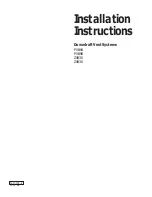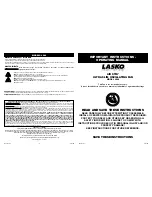
906-0731-01-05 Rev. C
ZOLL Ventilator Operator’s Guide
5-13
2020
Low O2 Supply Fault
Alarm triggers when the O
2
supply pressure is <35 psig (241 kPa) and the compressor is able to support ven-
tilation. When this occurs the device begins ventilation using the compressor. The alarm will continue to
sound as a medium priority alarm until the user acknowledges that ventilation is being provided using the
compressor by setting the FIO
2
to 21%. The alarm will cancel completely when the user sets to 21%.
NOTE
:
The device works with or without external O
2
. If O
2
is connected the device will not continue O
2
operation
unless the supply pressure is
≥
40 psig (276 kPa). This is done to prevent continuous cycling between alarms
during the inspiratory phase and no alarm during the expiratory phases. If low flow O
2
is available it can be
entrained through the Fresh Gas/Emergency Air Intake port using the optional O
2
reservoir. Maintain an
acceptable SpO
2
by adjusting the O
2
supply up or down to increase or decrease the amount of O
2
delivered
to the patient.
2030
Gas Intake Fault
Alarm triggers when the Fresh Gas/Emergency Air Inlet is blocked so that the compressor is not able to
deliver a breath within ±10% of the current settings and high pressure O
2
is available to support ventilation.
When this occurs the ventilator immediately switches to O
2
powered ventilation. To clear the alarm first set
the FIO
2
to 100% to acknowledge that the patient is being ventilated at 100%, clear the blockage and then
set the FIO
2
back to the original value. Once the blockage has been cleared operation with the compressor
will restart. If the blockage cannot be cleared, the alarm will resound, continue ventilation with FIO
2
set to
100% and ensure an adequate supply of O
2
.
NOTE
: A high vibration environment can trigger this alarm. If
necessary, the user can activate the O
2
Reservoir Mode while continuing to operate normally. This will sup-
press the alarm.
2053
Self Check Fault
Alarm triggers when the expiratory time is <170 ms for 3 consecutive breaths. When this occurs the device
attempts to reestablish a baseline by momentarily setting PEEP to 0 cm H
2
O and suspending triggered
breaths. This interruption lasts no longer than 2 breath cycles. The user should also check for leaks in the
hose and tubes
,
patient airway and exhalation valve. If recalibration is successful the alarm will automatically
cancel. If the device does not reset, manually ventilated the patient, replace the ventilator and contact the
service center for additional information
.
Mitigation/Info: Pneumatic Sensor: Airway Pressure, Check Circuit for Leaks/Disconnects, , Check Tube
2062
Exhalation System Fault
Alarm triggers when the airway pressure
,
PIP, measured at the end of expiration is >5 cm H
2
O above the
baseline pressure
,
PEEP. This is typically caused by a restriction of the exhalation valve or an occlusion/kink
in one or more of the breathing circuit tubes or hose. If the breathing circuit tubes appear to be intact the cir-
cuit should be replaced to eliminate the possibility of a bad exhalation valve. If the condition does not resolve
the user should manually ventilate the patient, replace the ventilator and contact the service center for addi-
tional information
.
Mitigation/Info: Check Patient Exhalation, Check Circuit for Kinked Hose/Tube, Check for Blocked Exhalation
2070
Airway Pressure High
Alarm triggers when the airway pressure, PIP, is > the high airway pressure limit for 2 consecutive breaths.
When the limit is reached, the flow decelerates to keep the PIP below the airway pressure for the duration of
the breath (inspiratory time). The user should check for kinks or blockage of the breathing circuit, exhalation
valve or patient airway. In some instances the cause can be an accumulation of secretions in the airway
which will require suctioning to clear. The user should also assess if the patient is fighting the ventilator
,
asyn-
chrony, or if the high airway pressure limit is set too low.
Mitigation/Info: Pressure Exceeds Limit Setting, Check Circuit for Kinked Hose/Tube, Check for Airway
















































